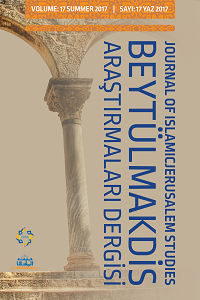
Journal of Islamicjerusalem Studies
Yazarlar: Mustafa KADAD
Konular:Tarih
DOI:10.31456/beytulmakdis.809571
Anahtar Kelimeler:Jerusalem,Displacement,Crusades,Settlements
Özet: The city of Bayt al-Maqdis enjoyed prosperity and its people enjoyed freedom for centuries until the arrival of the Crusades. As soon as the Fatimids seized the city from the Artuqids, change seemed inevitable as the region was soon lost to the first crusade. The Crusaders deliberately evacuated the Holy City and its environs, including its villages and towns through many means, perhaps the most prominent of which was the massacres they carried out in the cities and villages they occupied. They began by killing its people and emptied many of their lands by spreading fear that the inhabitants’ fate would be similar to that of others in cities such as Jerusalem. This was the Crusaders’ first step in their settlement policy, followed by the establishment of Crusader settlements to accommodate many of the crusading European immigrants. The Crusaders attempted to attract crusaders from Europe to settle in the Holy City with deceptive arguments, including through promises to protect their holy sites. These efforts were undertaken in order to populate those settlements, which were made a primary line of defence for the Holy City. As many decided to return to Europe, in order to continue with their settlement plans, they sought to resettle indigenous Christians whom they lured to their side. In conjunction with the Crusader settlement movement, much of the original inhabitants of the Holy Land were subject to forced displacement due to the Crusader occupation, thus the original inhabitants of different religions (Muslims, Christians and Jews) would take refuge in neighbouring Muslim countries regardless of the ruling authority in these lands and carried with them their knowledge, arts and sciences, to bring added value to the places they took refuge in, as a result of which they were embraced with affection and delight. It should be noted that many of the Christians of Bayt al-Maqdis, whom the crusades claimed to be coming to protect, had to undergo forced migration from their lands, which were taken over or destroyed by the crusading barbaric campaigns. The relentless struggle of the Muslims to retake these lands culminated with their liberation by Salah al-Din, who together with his successors worked to return the land to its original inhabitants, regardless of religion. This study relies on the inductive and contrastive descriptive approach to analyse the similarities and differences between the Crusader settlement and the Zionist settlement. The article arrives at a set of important outcomes, such as the necessity to continue the resistance in all its forms, with the certainty of the inevitable demise of the usurping Zionist entity, just as the Crusader entity had become extinct before. It becomes apparent that the similarities between both entities is very great and on several important issues, reaches a point of congruence.